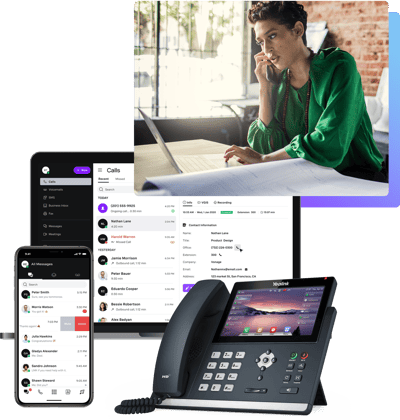How Does a Small Business Set Up VoIP?
VoIP offers several advantages over traditional, landline-based business phone systems. Not only can a Voice over Internet Protocol solution save you money today, but it’s also scalable and flexible enough to adapt as your business grows. In this article, we’ll walk you through the basics of setting up VoIP, so you can hit the ground running.

Getting the Most Out of VoIP
Every business needs a reliable set of communications technologies to power their operations and engage with customers or clients. Among the available options, over one-third of businesses use VoIP business phone systems, according to Business News Daily.
A word of advice: Before jumping to questions about business VoIP pricing, it’s important to determine whether VoIP is the best solution for your organization. This article will answer questions like “How does VoIP work?” and “How can small businesses maximize the benefits it offers?”
Keep reading for a brief overview of how small businesses can make the most of VoIP technology.
How Do Small Businesses Use VoIP?
VoIP stands for Voice over Internet Protocol, and the FCC defines it as “a technology that allows you to make voice calls using a broadband Internet connection instead of a regular (or analog) phone line.” In simple terms, VoIP is a cost-effective modern alternative to outdated technologies like convoluted landline phone systems.
Why Would a Business Want to Use VoIP (Instead of a Traditional Phone System)?
Businesses across a wide range of industries opt for VoIP solutions because they offer compelling benefits over traditional private branch exchange (PBX) configurations. When evaluating your options, consider the benefits of VoIP for small business, such as:
Cost-effectiveness, driven by lower overall costs, added features and flexibility, and consistent, subscription-based pricing models
Better call quality, provided there’s a reliable internet connection and plenty of bandwidth
Scalability, with it being quite easy to add new lines, configure existing lines, or incorporate advanced features into an existing setup
Mobility, as VoIP enables much more flexibility for remote workers, plus increased accessibility for customers
Increased security, as long as you work with a reputable VoIP provider like Vonage
What Is Required for VoIP Setup?
At the top of any list of VoIP setup requirements is a reliable, high-quality internet connection. Equipment-wise, this means you’ll need a modem and a router, as well as individual mobile devices (or VoIP phones) for making and receiving calls.
Chances are, you already have most of what you need. VoIP doesn’t require a specific type of modem or router. You will, however, need to download VoIP applications to mobile devices to use them for VoIP.
How to Set Up VoIP for Small Business
Setting up a VoIP system is relatively uncomplicated, and the provider you choose to work with will support you as you switch to VoIP. Here’s an overview of VoIP configuration step-by-step:
Choose a provider/solution. For small businesses, it’s especially important to work with the best provider for your needs. Consider each provider’s overall reputation, as well as things like security policies, pricing and value, and customer support.
Import existing phone numbers — or create new ones. In most cases, you’ll want to keep your existing number(s) in service, so your customers can easily reach you.
Add and configure users. Whether you have three or 300 employees, properly configuring your numbers ensures business continuity. As mentioned above, one of VoIP’s benefits for small businesses is that adding new users is simple.
Create a set of rules. This step involves configuring VoIP systems to accommodate all the needed features, like routing, call waiting, call forwarding, recording, and more.
Integrate VoIP with existing technologies. With a VoIP configuration in place, it’s easy to integrate the system with other existing applications. Integrating VoIP with a customer relationship management (CRM) system, for example, enables better communication and an improved user and customer experience. Most importantly, integrating VoIP with your CRM creates a digital “paper trail” that unites call logs and recordings with customer notes, transaction histories, and more.
Do I Need a Special Router for VoIP?
Generally, you won’t need a special type of router for VoIP configuration. The router’s role in VoIP is to enable businesses to make and receive calls over the internet (rather than a landline, for example). As long as your router is in good working order, it should be up to the task. With your modem and router likely already set up, simply download VoIP applications onto any devices you want to enable, and you’ll be well on your way.
Can I Just Plug a VoIP Phone Into My Router?
In most cases, you can indeed just plug a VoIP-ready phone into your router. You can consult your router’s documentation if you’re not sure whether it allows for a “plug-and-play” type of setup. If your router’s on the older side, it may require an upgrade.
Explore Vonage’s Modern VoIP Solution
If you’re looking for a modern VoIP solution for your business, Vonage has you covered. Whether you’re looking for a simple VoIP adoption or upgrade, or you’re thinking about VoIP within the context of a larger unified communications solution, we’re ready to work with you. (You can check out our plans online.)
